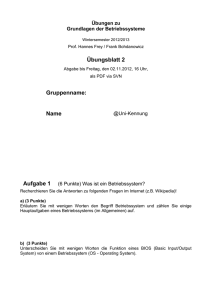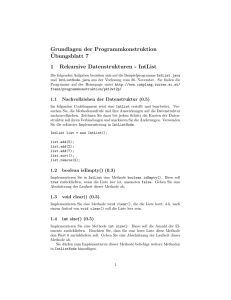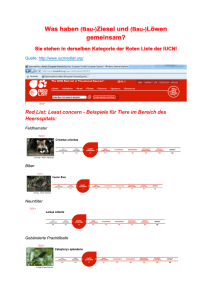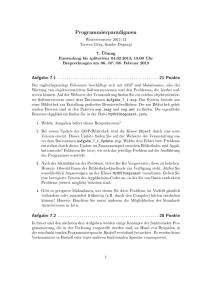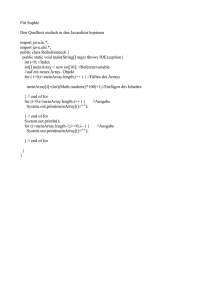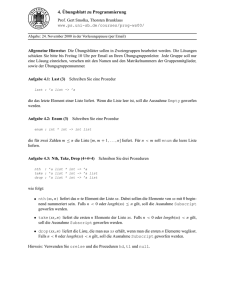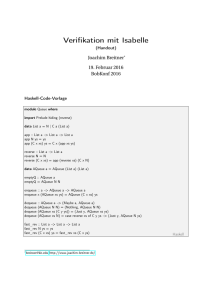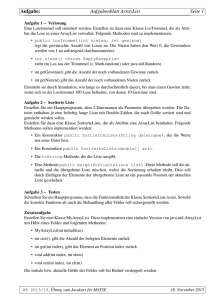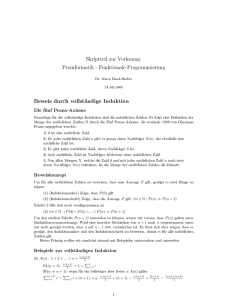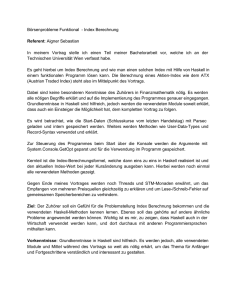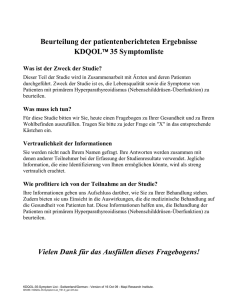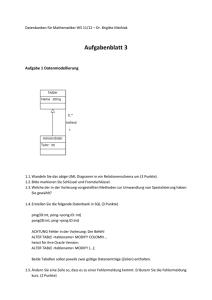Von der Entwurfsspezifikation zum Programm und zurück
Werbung
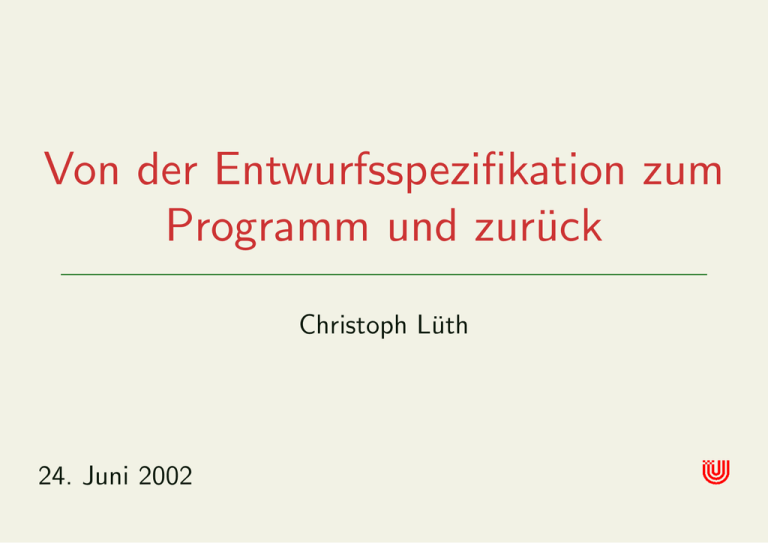
Von der Entwurfsspezifikation zum
Programm und zurück
Christoph Lüth
24. Juni 2002
TEKS 2
1
The Big Picture
Anforderungsspezifikation
• Lose
• Viele Modelle
•
Eigenschaften
|
Entwurfsspezifikation
• ausführbar
• monomorph
•
Definitionen
{z
CASL
Christoph Lüth: TEKS 2, 24. Juni 2002
Implementation
• Haskell
•C
}
TEKS 2
2
CASL vs. C und Haskell
Nicht in CASL, aber in . . .
• Haskell: Funktionen höherer Ordnung, Polymorphie
• C: Zustand, Variablen
In CASL, aber nicht in . . .
• C: alg. Datentypen
• C und Haskell: Subsorten, Partialität
Haskell
Christoph Lüth: TEKS 2, 24. Juni 2002
CASL
C
CASL
CASL und Haskell
CASL und Haskell: Das Problem
Haskell kennt
• Polymorphie (Typvariablen a, b) und
• Funktionen höherer Ordnung (Funktion f als Argument):
map :: (a-> b)-> [a]-> [b]
map f []
= []
map f (x:l) = f x: map f l
CASL kennt das nicht.
Christoph Lüth: TEKS 2, 24. Juni 2002
3
CASL und Haskell
4
Die Lösung
Emulation durch parametrisierte Spezifikationen
• Polymorphe und Funktionen höherer Ordnung durch
parametrisierte Spezifikation ersetzen
• Funktionale Argument und Typvariablen werden Parameter
• Funktionen entcurrieren
• Bei Benutzung instantiieren
Christoph Lüth: TEKS 2, 24. Juni 2002
CASL und Haskell
Beispiel: Aus . . .
(.) :: (b-> c)-> (a-> b)-> a-> c
(f. g) x = f (g x)
wird. . .
spec ComposeArg=
sorts Elem1,Elem2,Elem3
ops f:Elem1->Elem2; g:Elem2->Elem3
end
spec Compose[ComposeArg] = %def
op comp[g,f]:Elem1->Elem3
forall x:Elem1. comp[g,f](x)=g(f(x))
end
Christoph Lüth: TEKS 2, 24. Juni 2002
5
CASL und Haskell
6
Listen und map
Listen in CASL
• Siehe Basic/StructuredDatatypes
spec List [sort Elem]=
free type List[Elem] ::=
[]
| __::__ (first:? Elem; rest:? List[Elem])
Christoph Lüth: TEKS 2, 24. Juni 2002
CASL und Haskell
7
spec Map [sorts Elem1,Elem2; op f:Elem1->Elem2] =
List[sort Elem1] with List[Elem1]
|-> SourceList[Elem1]
and
List[sort Elem2] with List[Elem2]
|-> TargetList[Elem2]
then
op map[f]:SourceList[Elem1]->TargetList[Elem2]
forall x:Elem1; l:SourceList[Elem1]
. map[f]([]) = []
. map[f](x::l) = f(x)::map[f](l)
end
Christoph Lüth: TEKS 2, 24. Juni 2002
CASL und Haskell
8
spec PredArg =
sort Elem
pred p:Elem
end
spec Filter [PredArg] =
List[sort Elem]
then
op filter[p]: List[Elem] -> List[Elem]
forall x:Elem; l:List[Elem]
. filter[p]([]) = []
. filter[p](x::l) = (x::[] when p(x) else [])
++ filter[p](l)
end
Christoph Lüth: TEKS 2, 24. Juni 2002
CASL und Haskell
9
Fazit
• Für jede Funktion eigene Spezifikation (e.g. map, filter)
Christoph Lüth: TEKS 2, 24. Juni 2002
CASL und Haskell
9
Fazit
• Für jede Funktion eigene Spezifikation (e.g. map, filter)
• Für jede Anwendung und jede Instantiierung eigens
instantiierter Import.
Christoph Lüth: TEKS 2, 24. Juni 2002
CASL und Haskell
9
Fazit
• Für jede Funktion eigene Spezifikation (e.g. map, filter)
• Für jede Anwendung und jede Instantiierung eigens
instantiierter Import.
• Keinerlei Typinferenz.
Christoph Lüth: TEKS 2, 24. Juni 2002
CASL und Haskell
9
Fazit
• Für jede Funktion eigene Spezifikation (e.g. map, filter)
• Für jede Anwendung und jede Instantiierung eigens
instantiierter Import.
• Keinerlei Typinferenz.
• Möglich, aber sehr umständlich.
- ächz! -
Christoph Lüth: TEKS 2, 24. Juni 2002
Imperative Konzepte in CASL
Imperative Konzepte in CASL
Konzepte imperativer Programme:
• Zustand und Variablen
Christoph Lüth: TEKS 2, 24. Juni 2002
10
Imperative Konzepte in CASL
Imperative Konzepte in CASL
Konzepte imperativer Programme:
• Zustand und Variablen
• Imperatives Ausführungsparadigma:
Programm = Zustandstransformation
Christoph Lüth: TEKS 2, 24. Juni 2002
10
Imperative Konzepte in CASL
Imperative Konzepte in CASL
Konzepte imperativer Programme:
• Zustand und Variablen
• Imperatives Ausführungsparadigma:
Programm = Zustandstransformation
• Datentypen
Christoph Lüth: TEKS 2, 24. Juni 2002
10
Imperative Konzepte in CASL
Imperative Konzepte in CASL
Konzepte imperativer Programme:
• Zustand und Variablen
• Imperatives Ausführungsparadigma:
Programm = Zustandstransformation
• Datentypen
• Speicherverwaltung
Christoph Lüth: TEKS 2, 24. Juni 2002
10
Imperative Konzepte in CASL
Imperative Konzepte in CASL
Konzepte imperativer Programme:
• Zustand und Variablen
• Imperatives Ausführungsparadigma:
Programm = Zustandstransformation
• Datentypen
• Speicherverwaltung
Wie das in CASL?
Christoph Lüth: TEKS 2, 24. Juni 2002
10
Imperative Konzepte in CASL
Zustände in deklarativen Sprachen
Problem: zustandsabhängige Berechnungen
• z.B. getLine : String
• Bekanntes Problem in funktionalen Sprachen
• Bekannte Lösung: State Transformer
• Zustand wird (explizit oder implizit) “durch die Gegend
gereicht“
Christoph Lüth: TEKS 2, 24. Juni 2002
11
Imperative Konzepte in CASL
Zustandstransformationen
Eine Zustandstransformation ist parametrisiert über
• den Zustand s
• das Ergebnis a
data ST s a = ST (s-> (s, a))
• f :: ST s a ist eine vom Zustand s abhängige
Berechung mit dem Ergebnistyp a.
Christoph Lüth: TEKS 2, 24. Juni 2002
12
Imperative Konzepte in CASL
• ST ist ein Monade:
class Monad m a where
return :: a-> m a
(>>=) :: m a-> (a-> m b)-> m b
◦ Monadenstruktur erzwingt Zustandstransformationsstruktur
◦ Zustand wird immer nur weitergegeben
instance Monad (ST s) where
return a
= ST (\s-> (s, a))
(ST f) >>= g = ST (\s-> let (s1, a)= f s
ST g1 = g a
in g1 s1)
Christoph Lüth: TEKS 2, 24. Juni 2002
13
Imperative Konzepte in CASL
14
Beispiel
Speicher: Liste von Strings, Referenzen: Index in Liste
type Mem = ST [String]
-- Zustand
type Ref = Int
newRef :: Mem Ref
newRef = ST (\s-> (s++[""], length s))
readRef :: Ref-> Mem String
readRef r = ST (\s-> (s, s !! r))
writeRef :: Ref-> String-> Mem ()
writeRef r v = ST (\s-> (take r s ++
[v]++ drop (r+1) s, ()))
run :: Mem a-> a
run (ST f)= snd (f [])
Christoph Lüth: TEKS 2, 24. Juni 2002
Imperative Konzepte in CASL
15
Zusammenfassung ST
• Zustand wird
◦ als Parameter übergeben,
◦ mit dem Ergebnis zurückgeliefert.
• Zustand ist abstrakt:
◦ wird nur mit gegebenen Funktionen manipuliert;
◦ zustandsabhängige Berechungen werden nur mit (>>=) komponiert.
• Dadurch: immer genau ein Zustand
Christoph Lüth: TEKS 2, 24. Juni 2002
Imperative Konzepte in CASL
16
Zustände mit CASL
Signatur einer zustandsbehafteten Funktion
f :s×a→s×b
• Eingabewerte vom Typ a
• Rückgabewerte vom Typ b
• Benutzt Zustand vom Typ s
Benutzung:
• Zustand nie verdoppeln oder vergessen
• Immer nur mit vorgegeben Funktionen manipulieren, oder
weiterreichen.
Christoph Lüth: TEKS 2, 24. Juni 2002
Imperative Konzepte in CASL
• Problem: In CASL keine Tupel als Ergebnistyp. . .
• Lösung: Pair aus Basic/StructuredDatatypes
• . . . oder explizit:
spec Stateful[sort S][sort D] =
free type St[S,D] ::= st(state: S; data: D)
end
Christoph Lüth: TEKS 2, 24. Juni 2002
17
Datentypen in CASL und C
18
Datentypen in CASL und C
CASL
Int
Char
Boolean
String
—
free type ...
Array
Notation: S
[[t]]CASL
Christoph Lüth: TEKS 2, 24. Juni 2002
C
int und Freunde
char
boolean oder int
char *
t *
struct T ,union T
t a[c]
[[S]]C
t
Datentypen in CASL und C
19
Felder in CASL
• Aus Basic/StructuredDatatypes
spec Array
[ops min, max: Int axiom min <= max %(Cond_nonEmptyIndex)%]
[sort Elem] given Int
= sort Index = { i : Int . min <= i /\ i <= max }
then {
FiniteMap [sort Index fit sort S|-> Index]
[sort Elem fit sort T |-> Elem]
with
sort FiniteMap[Index,Elem] |-> Array[Elem],
ops [] |-> init
then
Christoph Lüth: TEKS 2, 24. Juni 2002
Datentypen in CASL und C
ops
20
__!__:=__ : Array[Elem] * Index *Elem -> Array[Elem];
__!__ :
Array[Elem] * Index ->? Elem
forall A: Array[Elem]; i: Index; e:Elem
. A!i:=e = A[e/i]
%(assignment_def)%
. A!i = eval(i,A)
%(evaluate_def)%
} reveal
sort Array[Elem],
ops init, __!__, __!__:=__
then %implies
forall A: Array[Elem]; i,j: Index; e,f: Elem
. not def init!i
. def (A!i:=e)!i
. (A!i:=e)!j = e if i=j
. (A!i:=e)!j = A!j if not (i=j)
end
Christoph Lüth: TEKS 2, 24. Juni 2002
Datentypen in CASL und C
Übersetzung von algebraischen Datentypen
• Enumerationen (nur nullstellige Konstruktoren):
free type T ::= C1 | C2 | ... | Cn
[[T ]]C = t
typedef enum {C1, C2, ..., Cn} t;
Christoph Lüth: TEKS 2, 24. Juni 2002
21
Datentypen in CASL und C
Nur ein Konstruktor:
• free type T ::= C(sel1: T1, ..., seln: Tn)
[[T ]]C = t *
typedef struct { [[T_1]] sel1; ...;
[[T_n]] seln; } t;
• Beispiel:
free type Book ::= Book(author: String,
title : String)
typedef struct { char *author;
char *title; } book;
Christoph Lüth: TEKS 2, 24. Juni 2002
22
Datentypen in CASL und C
• Der allgemeine Fall:
free type T ::=
C1(sel11: T11, ..., sel1n_1: T1n_1)
| C2(sel21: T21, ..., sel2n_1: T2n_2)
| ...
| Cm(selm1: Tm1, ..., selmn_m: Tmn_m)
◦ Ein struct pro Konstruktor
◦ Eine union für alle Varianten
◦ Eine Aufzählung aller Varianten
◦ Bei Rekursion Vorwärtsreferenzen beachten
Christoph Lüth: TEKS 2, 24. Juni 2002
23
Datentypen in CASL und C
[[T ]]C = t *
typedef enum {C1, ... Cm} t_var;
typedef struct { [[T11 ]] sel11; ...;
[[T1n_1]] sel1n_1; } t_var1;
...
typedef struct { [[Tm1 ]] selm1; ...;
[[Tmn_m]] selmn_m; } t_varm;
typedef struct { t_var t_discr;
union { t_var1 t_var1; ...;
t_varm t_varm;
} t_data; } t;
Christoph Lüth: TEKS 2, 24. Juni 2002
24
Datentypen in CASL und C
• Parameter sort P (der Spezifikation):
[[P ]]C = void *
◦ Kann mit jedem algebraischen Typ instantiiert werden;
◦ . . . aber nicht mit Basisdatentypen.
Christoph Lüth: TEKS 2, 24. Juni 2002
25
Datentypen in CASL und C
• Beispiel:
free type LTree[Elem] ::=
Empty | VeryEmpty
| Cons(hd: Elem,
tl: LTree[Elem])
| Node(lt: LTree[Elem],
data: Elem,
rt: LTree[Elem])
Ergibt:
Christoph Lüth: TEKS 2, 24. Juni 2002
26
Datentypen in CASL und C
27
[[LTree]]C = ltree mit
typedef enum { empty, veryEmpty,
cons, node } ltree_var;
typedef struct { void *hd;
struct ltree *tl; } ltree_cons;
typedef struct { struct ltree *lt;
void *data;
struct ltree *rt; } ltree_node;
typedef struct { ltree_var ltree_discr;
union { ltree_cons ltree_cons;
ltree_node ltree_node;
} ltree_data; } ltree;
Christoph Lüth: TEKS 2, 24. Juni 2002
Datentypen in CASL und C
28
• Vereinfachungen:
◦ Wenn genau eine nullstellige Variante vorhanden ist, diese durch den
ausgezeichneten Wert NULL modellieren.
• Beispiel: Listen (Basic/StructuredDatatypes)
free type List[Elem]::=
Empty | Cons (first :? Elem, rest :? Elem)
◦ In erster Näherung:
typedef enum { Empty, Cons } list_var;
typedef struct { void *first;
struct list *rest;} list_cons;
typedef struct { list_var list_discr;
union { list_cons list_cons;
} list_data; } list;
Christoph Lüth: TEKS 2, 24. Juni 2002
Datentypen in CASL und C
• Einfacher: Empty fällt weg
typedef struct { void* first;
struct list*rest; } list;
• Diskriminator: l == NULL
• Selektoren durch Feldselektion in C:
l-> first, l-> rest
Christoph Lüth: TEKS 2, 24. Juni 2002
29
Datentypen in CASL und C
• Konstruktor:
◦ Speicherbereich allozieren (malloc)
◦ Achtung, Speicherfreigabe (free) muß von Hand eingefügt werden
(wenn die Liste nicht mehr benutzt wird).
list *cons(void *hd, list *tl)
{
list *l;
if ((l= malloc(sizeof *l))== NULL) abort();
l-> first= hd;
l-> rest= tl;
return l;
}
Christoph Lüth: TEKS 2, 24. Juni 2002
30
Von der CASL-Spezifikation zum C-Programm
31
Von der CASL-Spezifikation zum C-Programm
Zwei Herangehensweisen:
1. Schrittweise Verfeinerung
• Anforderungsspezifikation schrittweise in Programm
überführen
• Problem: CASL — Rekursion, C — Iteration
• Lösung: Endrekursion entspricht Iteration
2. Invent & Verify
• Programm erfinden, dann verifizieren (Hoare-Kalkül)
Christoph Lüth: TEKS 2, 24. Juni 2002
Von der CASL-Spezifikation zum C-Programm
32
Implementation durch Verfeinerung
Anf.spez
Eigenschaften
P (f )
↓
Entw.spez. rekursive Fkt.
f = E[f ] ,→ f(...) . . .
↓
endrekursive Ftk. f = E 0[f ] ,→ while . . .
CASL
Christoph Lüth: TEKS 2, 24. Juni 2002
C
Von der CASL-Spezifikation zum C-Programm
Endrekursive Funktionen
Eine Funktion f : S → T der folgende Form
f(x) = f(K(x)) if B(x)
f(x) = H(x)
if not B(x)
ist endrekursiv und entspricht der Iteration:
[[T]] f([[S]] x)
{
[[S]] a= x;
while B(a) { a= K(a); }
return H(a);
}
Christoph Lüth: TEKS 2, 24. Juni 2002
33
Von der CASL-Spezifikation zum C-Programm
Kriterien für Endrekursivität
• Genau ein rekursiver Aufruf
• Rekursiver Aufruf außen (unter Fallunterscheidung)
• Eine Fallunterscheidung
Christoph Lüth: TEKS 2, 24. Juni 2002
34
Von der CASL-Spezifikation zum C-Programm
35
Beispiel
• Der Modulus
mod : Nat * Nat-> Nat
mod (x, y) = mod (x- y, y) if x >= y
mod (x, y) = x
if x < y
• Der größte gemeinsame Teiler:
gcd : Nat* Nat-> Nat
gcd(n, m) = gcd (m, mod(n, m)) if not (m= 0)
gcd(n, m) = n
if m= 0
Christoph Lüth: TEKS 2, 24. Juni 2002
Von der CASL-Spezifikation zum C-Programm
mod iterativ
Nach obiger Transformation:
int mod(int x, int y)
{
int a= x;
int b= y;
while (a>= b) { a= a- b; }
return a;
}
Optimierung:
Christoph Lüth: TEKS 2, 24. Juni 2002
36
Von der CASL-Spezifikation zum C-Programm
mod iterativ
int mod(int x, int y)
{
while (x>= y) { x= x- y; }
return x;
}
Christoph Lüth: TEKS 2, 24. Juni 2002
37
Von der CASL-Spezifikation zum C-Programm
gcd iterativ:
Nach obiger Transformation:
int gcd(int x, int y)
{
int a= x;
int b= y;
while (b != 0) { (a, b)= (b, mod(a, b)); }
return a;
}
Noch kein C: Tupelzuweisung!
Christoph Lüth: TEKS 2, 24. Juni 2002
38
Von der CASL-Spezifikation zum C-Programm
gcd iterativ:
Tupelzuweisung auflösen.
Dazu Hilfsvariable c.
int gcd(int x, int y)
{
int z;
while (y != 0) { z= x; x= y; y= mod(z, y); }
return x;
}
Christoph Lüth: TEKS 2, 24. Juni 2002
39
Von der CASL-Spezifikation zum C-Programm
Von der Rekursion zur Endrekursion
• Gegenbeispiel:
fact : Int-> Int
fact (x) = x* (fact (x-1)) if x > 0
fact (x) = 1
if x <= 0
Christoph Lüth: TEKS 2, 24. Juni 2002
40
Von der CASL-Spezifikation zum C-Programm
Von der Rekursion zur Endrekursion
• Gegenbeispiel:
fact : Int-> Int
fact (x) = x* (fact (x-1)) if x > 0
fact (x) = 1
if x <= 0
• Wie von Rekursion zur Endrekursion?
• Endergebniss in weiterem Parameter akkumulieren:
Christoph Lüth: TEKS 2, 24. Juni 2002
40
Von der CASL-Spezifikation zum C-Programm
• Dazu Hilfsfunktion fact’
fact : Int-> Int
fact n = fact’ (n, 1)
fact’ : Int* Int-> Int
fact’(x, a) = fact’(x-1, x*a)
fact’(x, a) = a
• Technik läßt sich verallgemeinern.
Christoph Lüth: TEKS 2, 24. Juni 2002
41
if x> 0
if x<= 0
Von der CASL-Spezifikation zum C-Programm
Überführung in Endrekursion
• Voraussetzung: lineare Rekursion
◦ d.h. genau ein rekursiver Aufruf
• Gegeben
f
: S→T
f (x) = φ(f (K(x)), E(x)) if B(x)
f (x) = H(x)
if ¬ B(x)
mit K : S → S, φ : T × R → T, E : S → R, H : S → T
• Überführung in endrekursive Form durch Hilfsfunktion
Christoph Lüth: TEKS 2, 24. Juni 2002
42
Von der CASL-Spezifikation zum C-Programm
• Aufrufschema: nach n Inkarnationen
f (x) = φ(φ(· · · (φ(b, an−1), . . .), a1), a0)
ai = E(K i(x)), b = H(K n(x))
Christoph Lüth: TEKS 2, 24. Juni 2002
43
Von der CASL-Spezifikation zum C-Programm
• Aufrufschema: nach n Inkarnationen
f (x) = φ(φ(· · · (φ(b, an−1), . . .), a1), a0)
ai = E(K i(x)), b = H(K n(x))
• Wenn es jetzt φ assoziative ist:
φ(φ(r, s), t) = φ(r, φ(s, t))
dann ist
f (x) = φ(φ(φ(· · · (φ(b, an−1), . . .), a2), a1), a0)
= φ(φ(· · · (φ(b, an−1), . . .), a2), φ(a1, a0))
= φ(· · · (φ(b, an−1), . . .), φ(a2, φ(a1, a0)))
= φ(b, φ(an−1, . . . φ(a2, φ(a2, φ(a1, a0)))))
• Das ist endrekursiv!
Christoph Lüth: TEKS 2, 24. Juni 2002
43
Von der CASL-Spezifikation zum C-Programm
Transformationsregel
• Für f : S → T mit
f (x) = φ(f (K(x)), E(x)) if B(x)
f (x) = H(x)
if ¬ B(x)
mit K : S → S, φ : T × T → T, E : S → T, H : S → T ,
• Wenn φ assoziativ und e neutrales Element:
φ(φ(r, s), t) = φ(r, φ(s, t))
φ(r, e) = r
• Dann ist die äquivalente endrekursive Formulierung:
f (x)
= g(x, e)
g(x, y) = g(K(x), φ(E(x), y)) if B(x)
g(x, y) = φ(H(x), y)
if ¬ B(x)
Christoph Lüth: TEKS 2, 24. Juni 2002
44
Von der CASL-Spezifikation zum C-Programm
Allgemeine Transformationsregel
• Für f : S → T , φ : T × R → T
f (x) = φ(f (K(x)), E(x)) if B(x)
f (x) = H(x)
if ¬ B(x)
• Gegegebn ψ : R × R → R so dass
φ(φ(r, s), t) = φ(r, ψ(s, t))
• Dann ist die äquivalente endrekursive Formulierung:
f (x)
= g(K(x), E(x))
if B(x)
f (x)
= H(x)
if ¬ B(x)
g(x, y) = g(K(x), ψ(E(x), y)) if B(x)
g(x, y) = φ(H(x), y)
if ¬ B(x)
Christoph Lüth: TEKS 2, 24. Juni 2002
45
Von der CASL-Spezifikation zum C-Programm
Sonderfall: Prädikate
• Für pred p: S mit
p(x) ⇔ φ(p(K(x)), E(x)) if B(x)
p(x) ⇔ H(x)
if ¬ B(x)
mit K : S → S, pred E : S, pred p : S, pred H : S
• Sei φ binär, assoziativ und e neutrales Element.
• Dann ist die äquivalente endrekursive Formulierung:
p(x)
⇔ q(x, e)
q(x, y) ⇔ q(K(x), φ(E(x), y)) if B(X)
q(x, y) ⇔ φ(H(x), y)
if ¬ B(x)
Christoph Lüth: TEKS 2, 24. Juni 2002
46
Von der CASL-Spezifikation zum C-Programm
Implementation rekursiv definierter
Funktionen
1. Pattern matching entfernen, Lexikalik an C anpassen
• z.B. Konstruktor von :: nach cons umbenennen
2. Umformen in linearrekursive Form, wo möglich;
3. Linearrekursion in Endrekursion, wo möglich;
4. In C auskodieren.
Christoph Lüth: TEKS 2, 24. Juni 2002
47
Von der CASL-Spezifikation zum C-Programm
Beispiel: Enthaltensein
• Originaldefinition:
not (x eps [])
x eps (x::L)
(x eps (y::L) <=> x eps L if not (x= y)
• Ohne Pattern-Matching:
not (x eps xs)
if xs = empty
x eps xs
if not (xs= empty)
/\ first xs= x
x eps xs <=> x eps (rest xs)
if not (xs= emty) /\ not (first xs= x)
Christoph Lüth: TEKS 2, 24. Juni 2002
48
Von der CASL-Spezifikation zum C-Programm
49
• Linearekursiv (ersten beiden Fälle zusammenfassen)
(xs = empty => not x eps xs) \/
(not (xs= empty) /\
(first xs= x) => x eps xs)
if xs= empty \/ first xs= x
x eps xs <=> x eps (rest xs)
if not (xs= empty) /\ not (first xs= x)
Benutzt: A ∨ (¬A ∧ B) ⇔ (A ∨ ¬A) ∧ (A ∨ B) ⇔ (A ∨ B)
Ist schon endrekursiv!
Christoph Lüth: TEKS 2, 24. Juni 2002
Von der CASL-Spezifikation zum C-Programm
• Implementation in C:
bool eps(void *a, list *l)
{
void *x= a; list *m= l;
while (!(m == NULL) && (m-> first!= x)) {
m= m-> rest;
}
if (m == NULL) return FALSE;
if (!(m == NULL) && (*m-> first)== *x)
return TRUE;
}
Christoph Lüth: TEKS 2, 24. Juni 2002
50
Von der CASL-Spezifikation zum C-Programm
• Optimierung:
◦ Lokale Variablen unnötig;
◦ Nach Schleifendurchlauf gilt Abbruchbedingung.
◦ Immer noch ein Problem: Gleichheit der Elemente
(hier: gleiche Referenz — nicht optimal).
bool eps(void *a, list *l)
{
while (!(l == NULL) && (l-> first!= a)) {
l= l-> rest;
}
return l != NULL;
}
Christoph Lüth: TEKS 2, 24. Juni 2002
51
Von der CASL-Spezifikation zum C-Programm
Beispiel: Länge einer Liste
• Rekursive Definition:
length : List[Elem]-> Nat
length xs = 0
if isEmpty(xs)
length xs = 1+ length (rest xs)
if not(isEmpty(xs))
• Endrekursiv:
length xs = len xs 0
len(xs, n) = n
if isEmpty(xs)
len(xs, n) = len(rest xs, n+1)
if not (isEmpty(xs))
Christoph Lüth: TEKS 2, 24. Juni 2002
52
Von der CASL-Spezifikation zum C-Programm
Beispiel: Listenreversion
• Rekursive Definition:
rev xs = xs
if isEmpty(xs)
rev xs = rev (rest xs) ++ ((first xs)::[])
if not (isEmpty(xs))
Christoph Lüth: TEKS 2, 24. Juni 2002
53
Von der CASL-Spezifikation zum C-Programm
Beispiel: Listenreversion
• Rekursive Definition:
rev xs = xs
if isEmpty(xs)
rev xs = rev (rest xs) ++ ((first xs)::[])
if not (isEmpty(xs))
• Endrekursiv:
rev xs
= rev’(xs, [])
rev’(xs, ys) = ys
if isEmpty(xs)
rev’(xs, ys) = rev’(rest xs, (first xs)::ys)
if not (isEmpty(xs))
Christoph Lüth: TEKS 2, 24. Juni 2002
53
Von der CASL-Spezifikation zum C-Programm
• In C codiert (optimierte Version):
list *rev(list *xs)
{
list *ys;
while (xs != NULL) {
ys= cons(xs-> first, ys);
xs= xs-> rest;
}
return ys;
}
Christoph Lüth: TEKS 2, 24. Juni 2002
54
Von der CASL-Spezifikation zum C-Programm
Zusammenfassung
Von der CASL-Spezifikation zum C-Programm
• Zustand als expliziten Parameter (wenn nötig)
• Datentypen systematisch übersetzen
• Implementation durch schrittweise Verfeinerung:
◦ Rekursion in Endrekursion überführen, wo möglich;
◦ Endrekursion durch Iteration implementieren.
• oder Invent & Verify:
◦ Funktion spezifiziert mit Vor- und Nachbedingung
◦ Frei implementieren
◦ Verifikation mit dem Hoare-Kalkül
Christoph Lüth: TEKS 2, 24. Juni 2002
55
Von der CASL-Spezifikation zum C-Programm
56
Bewertung
Von der CASL-Spezifikation zum C-Programm
• Vorteile
◦ systematischer Übergang
◦ schematisch (potentiell automatisierbar)
Christoph Lüth: TEKS 2, 24. Juni 2002
Von der CASL-Spezifikation zum C-Programm
56
Bewertung
Von der CASL-Spezifikation zum C-Programm
• Vorteile
◦ systematischer Übergang
◦ schematisch (potentiell automatisierbar)
• Nachteile
◦ Aufwändig
◦ Fehleranfällig: Zustandstransformationen, Endrekursion
◦ Mangelnde Features in CASL:
Polymorphie, Funktionen höherer Ordnung
◦ Mangelnde Werkzeugunterstützung
Christoph Lüth: TEKS 2, 24. Juni 2002
